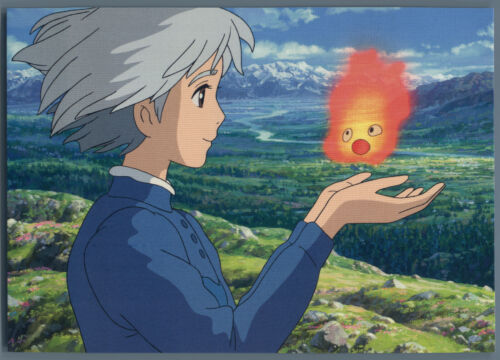“Howl’s Moving Castle”: The Complexity of a Masterpiece
“Howl’s Moving Castle” is rich in beautiful animated scenery, interactive, interesting characters, and powerful themes.

“Howl’s Moving Castle is a complex yet beautiful film.
February 3, 2023
“Howl’s Moving Castle” is a Studio Ghibli film that was released on June 17, 2005. The film was produced by Toshio Suzuki and written and directed by Hayao Miyazaki, the mind behind some of Studio Ghibli’s best projects, including “Spirited Away” (2001) and “Kiki’s Delivery Service” (1989). “Howl’s Moving Castle” follows the heroine, Sophie, as she is cursed by the Witch of the Waste to age dramatically into an old woman and forced to escape her mundane life. Sophie seeks the wizard Howl Pendragon, who she had a chance encounter in her hometown while he was visiting the area. The story follows the two of them as they grow in their relationship with each other and travel to different parts of the stunning animated world. There are also quite a few charming side characters who are introduced as well, such as Calcifer, a fire demon that assists in helping move Howl’s home, and Markl, a small boy who’s an apprentice to Howl. According to GameRant, as the plot develops, many complex themes are introduced to us in the form of conflicts in their fantasy world, such as anti-war symbolism influenced by the US-led War on Terror. Some other interesting concepts that are introduced include the importance of confronting your inner demons as well as your inner child, compassion, and what it means to truly have humanity.
According to GameRant, Miyazaki was very against war in all ways, having witnessed the brutality of WWII and the War on Terror, and he was actively against the self-proclaimed righteous of a country going to war against any other country. His outlook on this had a big impact on the messages and the characters in the movie. To begin, the story opens with a war being evidently waged in the town Sophie lives in, which is unspecified, but from the beginning we see what look like nationalist rallies being held and various war aircraft flying through the sky. The war going on does not initially seem like an essential part of the plot, as the main conflict presents itself to be Sophie being turned into a hag by the Witch of the Waste, but instead of staying a detail in the background it turns into a driving force of the themes of the movie and a central component in developing Howl’s character. The cause of the war remains purposely vague as a way to generalize the events of warfare and explain that no matter what is being fought for or what over, there is still a tremendous amount of loss that happens. As the plot progresses, Sophie finds Howl and the other characters and lives with them in Howl’s Moving Castle, and Sophie and Howl begin to develop a relationship with one another. However, this is not necessarily the focus of the movie going forward; rather, it is the external threat of war to the main cast and their world that becomes more and more pertinent.
Howl is first introduced to the viewers as a charming, mysterious, and somewhat dramatic character. He is initially secretive, disappearing through a door to a place no one knows for hours on end. However, later in the movie, his character becomes more rounded, he gains more depth than just being an eccentric and powerful wizard, and the viewers learn about his motives. He made a deal with a demon very young, Calcifer, the very demon that moves his house, and he gave the demon his heart to bind him in his service. In doing this though, it stunted Howl, making him more prone to childish driving forces like vanity and pride. We learn as an audience that he wants to be free from the Order of Wizards he trained under and not have anyone tell him what to fight for because he has seen how much damage the war has caused. He just wants to escape it all, to run away to a place where he doesn’t have to keep fighting, which we learn he has been doing everyday in going through the rouge door. Howl had been fighting rogue wizards and the forces contributing to the war, believing that the conflict was needless. While he was doing this, he was gradually morphing into the form he was using to fight them, a bird creature, permanently. All of the antagonistic forces on the other side of the war are presented as grotesque beings, representing how people lose their humanity after all of the fighting and bloodshed, and we see Howl begin to lose his humanity too, even though he is the protagonist in the movie. Toward the end of the movie, through his relationship with Sophie and ensuing maturity, he decides he needs to fight in order to protect the people that he has learned to love: Sophie, Calcifer, and Markl. At the end of the film, he almost transforms completely, and nearly loses his life, but Sophie is able to save him by giving him his heart back with Calcifer’s help, symbolizing both the healing through their love and his return to his humanity as the fighting ends. Overall, Miyazaki presents his anti-war beliefs, the healing properties of love, and the importance of healing one’s inner child through Howl’s character.
Miyazaki is a renowned filmmaker with many great movies under his belt, but “Howl’s Moving Castle” is truly a movie like no other, with layers of meaning behind everything coupled with lovely cinematography and breathtaking visuals. It is a brilliant achievement and one that deserves to be recognized for what it is: a masterpiece.








